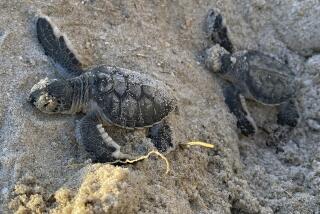High-Powered Boats, Development Threaten Manatees : Ecology: The greatest peril to the mermaids of myth, however, is a dwindling food supply, the coastal sea grass that is rapidly disappearing.
- Share via
MIAMI — A century from now, lonely sailors may still tell stories of sultry Caribbean mermaids, but conservationists fear the gentle manatees that inspired the myth will have vanished from the Earth.
The friendly, floating, 10-foot-long sea cows are one of the world’s most endangered sea mammals.
Their sluggish swimming pace makes them vulnerable to the high-powered boats that speed across Florida waterways.
The greatest threat to their survival, however, is a dwindling food supply--the coastal sea grass that’s rapidly disappearing because of development and siltation.
“The dam may burst sometime in the near future,” warned Jay Gorzelany of Mote Marine Laboratory in Sarasota. “Eventually, you’re going to reach a critical level where there’s just not enough room for manatees and humans to coexist--and you may have a massive manatee die-off.”
The West Indian manatees and their Old World relative, the dugong, are unique. They are the only vegetarian sea mammals. Their closest relative is a land animal, the elephant. Like many whales and dolphins, they apparently abandoned the land for the ocean millions of years ago.
Manatees sometimes nurse their young upright in the water, and, with their forward-looking eyes, can be mistaken for a human being at a distance. Historians believe early explorers to the New World did just that, creating the mermaid myth.
The precise number of West Indian manatees is unknown. Florida has the majority, with more than 1,800 counted in an aerial census last year. Small colonies exist on some Caribbean islands and in Central and South America, but none are believed to exceed 100 or so.
“If the manatees can’t be saved in Florida with our ample economic resources and our fairly educated populace, then I don’t think it will be done in developing countries,” said Kipp Frohlich, protected species administrator for Florida’s Department of Environmental Protection.
The state and federal government have taken some basic conservation steps.
Boat speeds are increasingly regulated in manatee areas. Deaths caused by humans, principally boaters, have dropped somewhat over the last five years.
Next summer, the U.S. Fish and Wildlife Service is opening a staging area at the Kennedy Space Center to gradually release some of 50 captive manatees. The “soft release” pens were developed because manatees freed directly into the wild have died almost immediately, according to Robert Turner, the agency’s manatee recovery coordinator.
Until the staging pens work, Turner said the agency must maintain a controversial ban on sex between captive manatees. Males and females had to be separated because there is no more room or money to keep captive calves. The animals cost up to $40,000 a year just to feed.
But breeding manatees is not the problem, scientists agree. New data from Bruce Ackerman of the state’s Florida Marine Research Institute shows female manatees may have calves earlier and more frequently than once thought.
Ackerman is cautious about his unfinished research. But, he said, the short-term manatee count seems to be increasing in some areas because of increased manatee births and decreased deaths.
Environmentalists remain skeptical.
“We’ve averaged about 160 manatees dying a year for the last four years,” said Nancy Sadusky of the Maitland-based Save the Manatee Club, headed by singer Jimmy Buffett. “The population is going nowhere. If we continue at this rate, they are definitely headed for extinction.”
Even experts who think the numbers are rising in the short run worry about the future.
They note that almost all adult manatees have been hit at least once by a boat; Ackerman, for example, counted 22 different propeller hits on one animal. Propeller hits are so universal, biologists use them to identify the animals, keeping a book of scar patterns as a central record.
Ackerman worries that the dip in boat deaths over the last two years will be reversed because of Florida’s increasing population; 1,000 people a day move into the state.
Loss of habitat is the darkest cloud, all agree.
Adult manatees eat 100 to 200 pounds of green plants a day. They even relish the nuisance plants that clog some Florida waterways. But the staple of their diet is sea grass, which is disappearing rapidly.
“Tampa Bay has already lost 65% or 75% of its sea grasses,” said Turner. “Even inland development contributes--the runoff that comes down the river reduces the light in the water, which reduces the sea grass.”
The sea grasses will recover if water quality improves, but the long-range trends are not good, he said.
More to Read
Sign up for Essential California
The most important California stories and recommendations in your inbox every morning.
You may occasionally receive promotional content from the Los Angeles Times.













